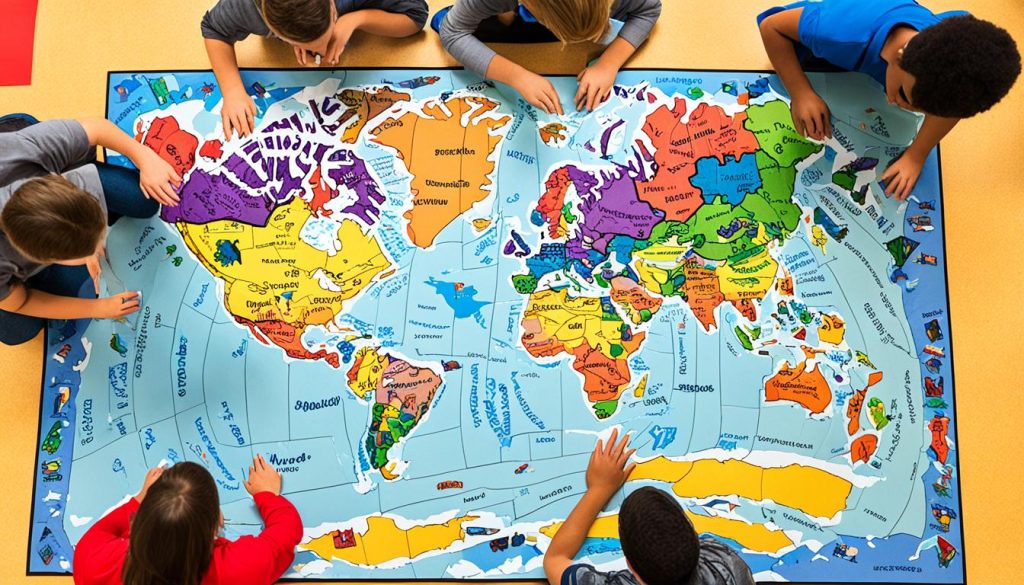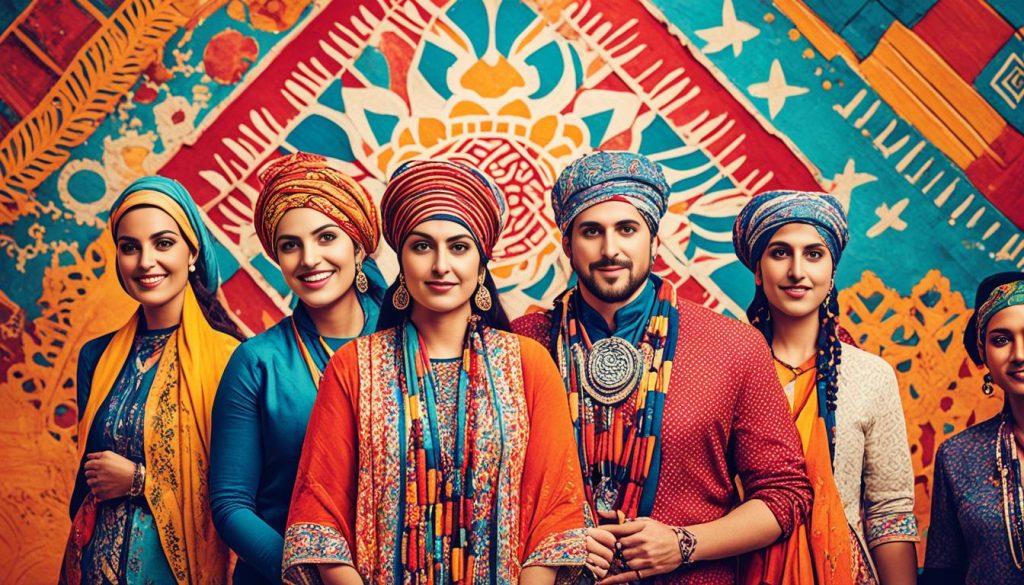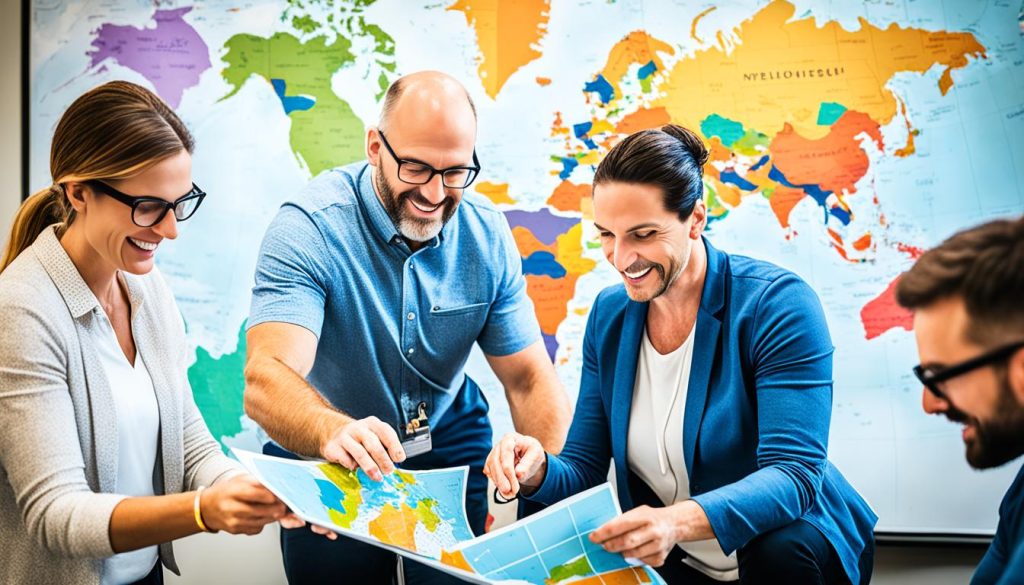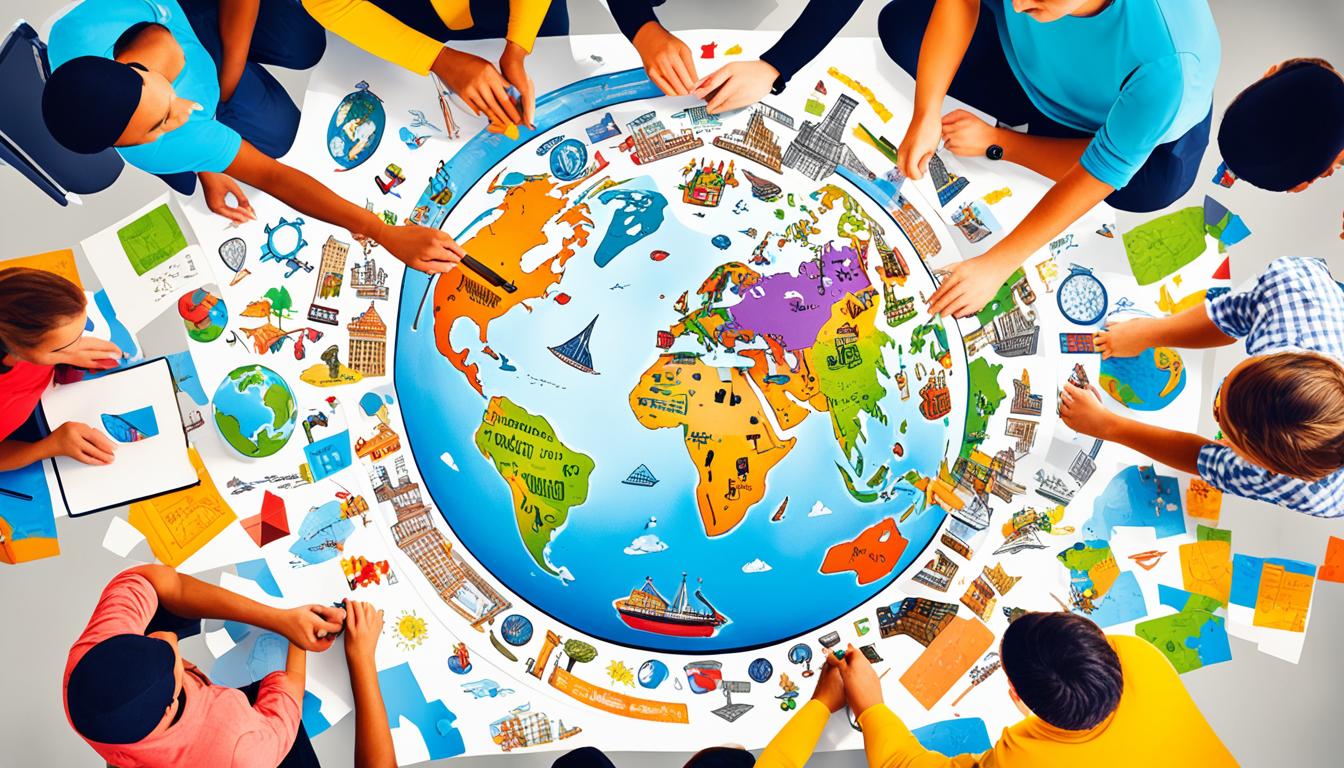The modern era calls for an educational system that empowers students to become independent learners capable of shaping their futures. The objective of college and career readiness does not merely entail acquiring specific knowledge and skills, but demands the development of critical thinking and creative problem-solving abilities. This paper argues that the most important educational policy to prepare students for college and careers is fostering these abilities to cultivate independent learners.
Key Takeaways
- Developing cross-cultural competence and international perspectives is crucial for success in a globalized world.
- Fostering global citizenship and intercultural communication skills prepares students for worldwide collaboration.
- Diversity and inclusion in the classroom promote multilingual education and study abroad opportunities.
- International education and multicultural learning experiences enhance language immersion and world languages proficiency.
- Integrating global thinking and problem-solving skills into the curriculum is essential for college and career readiness.
The Importance of Global Thinking and Problem-Solving
In the ever-changing landscape of the global economy and technology, the ability to think globally and problem-solve effectively has become increasingly crucial. As information becomes obsolete at a rapid pace, rote memorization and rigid curriculums fail to prepare students for a world that demands innovators, decision-makers, and analytical thinkers. It is the development of critical thinking and creative problem-solving skills that enables individuals to adapt, innovate, and continue learning throughout their lives.
Adapting to a Rapidly Changing World
The modern era calls for an educational system that fosters global thinking and problem-solving skills to empower students as independent learners capable of shaping their futures. The objective of college and career readiness goes beyond acquiring specific knowledge and skills; it demands the cultivation of critical thinking and innovative problem-solving abilities that allow students to thrive in a constantly evolving world.
Developing Critical Thinking and Innovation
In a world that needs innovative thinkers and decision-makers, the development of critical thinking and creativity is paramount. By nurturing these abilities, students can adapt to new challenges, find creative solutions, and continue learning throughout their lives, ultimately becoming the global citizens our world requires.
Nurturing Global Citizens
The cultivation of global thinking and problem-solving skills is essential in shaping the next generation of global citizens. These skills empower students to navigate the complex, interconnected world, foster international collaboration, and contribute to addressing global issues with innovative solutions.
Integrating Global Perspectives into the Curriculum
As educators, it’s crucial to cultivate a curriculum that integrates global perspectives, multicultural resources, and interdisciplinary learning. By exposing students to diverse international resources and global issues, you can foster a deeper understanding of the interconnected world they will navigate.
Incorporating Multicultural Literature and Resources
Incorporate a diverse range of multicultural literature and resources into your classroom, representing authors, stories, and perspectives from around the globe. This exposure not only broadens students’ horizons but also cultivates empathy, respect, and a deeper appreciation for cultural differences.
Exploring Global Issues across Subject Areas
Integrate global issues and challenges into your curriculum across various subject areas, from history and geography to science and the arts. Encourage students to analyze these complex problems from multiple global perspectives, developing their critical thinking and problem-solving skills in the process.
By weaving global perspectives and international resources throughout your instructional design, you can create a dynamic and engaging learning environment that prepares students for the demands of the 21st-century world.

Creating a Culturally Diverse Learning Environment
In a world that is increasingly interconnected, fostering a culturally diverse classroom and an inclusive learning environment is crucial for preparing students to thrive in a multicultural global landscape. By embracing diversity and incorporating multicultural education practices, educators can create learning experiences that celebrate differences, promote empathy, and cultivate well-rounded global citizens.
One key aspect of cultivating a diverse learning environment is incorporating diverse perspectives and resources into the curriculum. This may involve selecting multicultural literature, incorporating case studies from different cultural contexts, and encouraging students to explore global issues through an interdisciplinary lens. By exposing students to a wide range of cultural narratives and worldviews, you can help them develop a deeper understanding and appreciation for the richness of human diversity.
Additionally, creating opportunities for cross-cultural exchange and collaboration can further enhance the culturally diverse classroom experience. This may involve facilitating group projects, hosting cultural festivals or celebrations, or organizing virtual exchanges with students from different parts of the world. Such experiences not only foster inclusive learning but also help students develop essential skills, such as effective communication, empathy, and global problem-solving.
Furthermore, it is crucial for educators to engage in ongoing professional development to enhance their own cultural competence and sensitivity. By deepening their understanding of different cultures, teaching strategies, and inclusive practices, educators can create learning environments that are welcoming, affirming, and empowering for all students, regardless of their cultural background.
Ultimately, cultivating a culturally diverse learning environment is not just about meeting educational goals; it is about preparing students to thrive in an increasingly globalized world, where the ability to collaborate, communicate, and problem-solve across cultural boundaries is paramount.
Developing Cultural Competence and Sensitivity
In an increasingly interconnected world, cultivating cultural competence and sensitivity has become paramount in education. By fostering a deeper understanding of diverse cultural perspectives, students can develop the empathy and respect necessary to thrive in a global society.
Understanding Cultural Differences
Embracing cultural diversity requires an active exploration of the nuances that shape different worldviews and traditions. Encouraging students to engage with multicultural literature, films, and firsthand accounts can broaden their cultural understanding and challenge preconceived notions. This exposure helps students recognize and appreciate the unique experiences and contributions of individuals from various cultural backgrounds.
Building Empathy and Respect
Cultivating empathy and respect is essential for fostering cultural competence and cultural sensitivity. By stepping into the shoes of others, students can develop a deeper appreciation for diverse perspectives and a genuine willingness to engage in meaningful cross-cultural dialogue. Collaborative projects and discussions that promote active listening and open-mindedness can further strengthened these critical social-emotional skills.
Ultimately, the development of cultural competence and sensitivity equips students with the necessary tools to navigate an increasingly globalized world with confidence, curiosity, and a commitment to inclusive and respectful interactions.

Education for a Global World
In today’s interconnected and rapidly evolving world, education must adapt to equip students with the necessary skills to thrive as global citizens. Global education empowers learners to navigate the complexities of a diverse, multicultural society, fostering a deeper understanding and appreciation for different cultures, perspectives, and ways of life.
Embracing Diversity and Inclusion
By promoting diversity and inclusion within the classroom, educators can create an environment that celebrates the unique contributions of each individual. This approach encourages students to embrace their own cultural identities, while also developing empathy and respect for the experiences of others. Through meaningful dialogues and collaborative projects, students gain invaluable insights into intercultural understanding, preparing them for successful cross-cultural communication in their future endeavors.
Fostering Cross-Cultural Communication
Effective cross-cultural communication is a critical skill in today’s globalized world. Educators can help students develop this competency by incorporating diverse perspectives, literature, and resources into the curriculum. By exploring global issues, studying world languages, and engaging in virtual exchanges, students gain a deeper understanding of different cultures and learn to navigate the nuances of intercultural understanding. This holistic approach equips learners with the tools to thrive in an increasingly interconnected world.
Promoting Global Collaboration and Partnerships
In today’s interconnected world, global collaboration and international partnerships have become essential for preparing students to thrive in a globalized environment. By fostering these connections, educators can expand students’ worldviews, enhance their cross-cultural connections, and cultivate a deeper understanding of diverse perspectives.
Virtual Exchange Programs
One effective way to promote global collaboration is through virtual exchange programs. These innovative initiatives connect students from different countries and cultures, enabling them to engage in synchronous and asynchronous activities, such as joint project work, video conferences, and shared discussions. By leveraging technology, virtual exchange programs break down geographic barriers and provide valuable international student engagement opportunities.
International Student Collaborations
Encouraging international student collaborations can also be a powerful tool for fostering global thinking and problem-solving skills. Collaborative learning experiences that bring together students from diverse backgrounds allow them to share knowledge, exchange ideas, and develop a deeper appreciation for cultural differences. Such partnerships not only enhance academic growth but also nurture essential soft skills, such as communication, teamwork, and cultural sensitivity.
Ultimately, by promoting global collaboration and international partnerships, educators can empower students to become engaged global citizens, capable of navigating the complexities of the modern world and contributing to meaningful cross-cultural connections.

Nurturing Critical Thinking and Problem-Solving Skills
In the ever-evolving world, the development of critical thinking development and problem-solving skills has become increasingly crucial for student success. By fostering an environment that encourages inquiry-based learning and the application of knowledge to real-world scenarios, educators can empower students to become independent thinkers and problem-solvers.
Inquiry-Based Learning
Embracing an inquiry-based learning approach allows students to actively engage with the material, ask questions, and develop their own understanding. This process not only strengthens critical thinking development but also cultivates a growth mindset, where failure is viewed as an opportunity for learning and growth.
Real-World Problem-Solving
Integrating real-world application into the curriculum provides students with the chance to apply their problem-solving skills to authentic challenges. This approach not only enhances their understanding of the subject matter but also prepares them to tackle the complexities they may face in their future careers and personal lives.
By nurturing these essential skills, educators can empower students to become independent learners, ready to navigate the ever-changing landscape of the global marketplace and contribute to the betterment of their communities.
Professional Development for Educators
To foster global competence and culturally responsive teaching among students, it is essential to provide comprehensive educator professional development programs. These programs should equip teachers with the necessary teaching strategies to create inclusive and engaging learning environments that celebrate diversity and promote international perspectives.
Culturally Responsive Teaching Strategies
Culturally responsive teaching strategies empower educators to create learning experiences that are relevant, affirming, and responsive to the diverse backgrounds and experiences of their students. By incorporating multicultural literature and global resources into the curriculum, teachers can help students develop a deeper understanding and appreciation for different cultures, traditions, and worldviews.
Global Competence Training
In addition to culturally responsive teaching, educators must also be equipped with the knowledge and skills to foster global competence among their students. Through global competence training, teachers can learn how to facilitate cross-cultural dialogues, promote international collaboration, and integrate worldwide perspectives into their teaching practices. This comprehensive professional development equips educators to cultivate globally-minded, problem-solving students who are prepared to thrive in the 21st-century world.

Overcoming Challenges in Global Education
Providing a global education that fosters critical thinking and problem-solving skills is not without its challenges. Limited resources and access to quality educational opportunities, as well as navigating cultural differences, can present significant barriers to achieving this goal.
Limited Resources and Access
One of the primary obstacles in global education challenges is the disparity in access to resources, both physical and digital. Underfunded schools, especially in developing regions, often lack the necessary infrastructure, technology, and educational materials to effectively implement a curriculum focused on cultivating critical thinking and problem-solving skills. This resource limitation can hinder students’ ability to engage in hands-on, inquiry-based learning experiences that are essential for developing these crucial abilities.
Navigating Cultural Differences
Another significant challenge in delivering a global education is the need to navigate the diverse cultural differences that exist across the world. Educators must be mindful of incorporating culturally relevant and responsive teaching strategies to ensure that the learning environment is inclusive and respectful of the varied backgrounds and perspectives of their students. Failure to address these cultural differences can lead to misunderstandings, biases, and a lack of engagement, ultimately hindering the development of cross-cultural competence and global citizenship.
| Global Education Challenges | Impact on Student Learning |
|---|---|
| Resource Limitations | Reduced access to essential educational materials, technology, and hands-on learning opportunities, hindering the development of critical thinking and problem-solving skills. |
| Cultural Differences | Lack of cultural responsiveness and inclusivity in the learning environment, leading to misunderstandings, biases, and a lack of engagement, which can impede the cultivation of global competence and cross-cultural understanding. |
Overcoming these challenges in global education requires a multi-faceted approach that addresses both resource constraints and cultural diversity. Innovative strategies, such as leveraging digital resources, forging international partnerships, and implementing culturally responsive teaching practices, can help bridge these gaps and provide equitable access to a high-quality, globally-minded education.
Conclusion
As the world becomes increasingly interconnected, the need for developing global thinking and problem-solving skills has never been more crucial. The modern education system must evolve to empower students with the critical thinking, creativity, and adaptability required to thrive in a rapidly changing global landscape.
By integrating global perspectives into the curriculum, fostering a culturally diverse learning environment, and nurturing cross-cultural competence, educators can cultivate globally-minded citizens capable of navigating complex challenges. Through collaborative learning experiences, virtual exchange programs, and authentic problem-solving tasks, students will gain the necessary tools to become independent thinkers, effective communicators, and innovative problem-solvers.
Ultimately, the transformative power of global education lies in its ability to equip the next generation with the skills and mindset to address the world’s most pressing issues. By prioritizing the development of these essential abilities, educational institutions can position students for success in an increasingly interconnected and dynamic world.
FAQ
What is the importance of developing global thinking and problem-solving skills?
How can educators integrate global perspectives into the curriculum?
What are the benefits of creating a culturally diverse learning environment?
How can educators develop cultural competence and sensitivity in their students?
What are some effective strategies for promoting global collaboration and partnerships in education?
How can educators nurture critical thinking and problem-solving skills in their students?
What are the challenges in implementing global education, and how can they be addressed?
Source Links
- https://www.linkedin.com/pulse/importance-fostering-critical-thinking-creative-skills-sonja-bloetner
- https://www.mbu.edu/blog/mbu-news/critical-thinking-skills/
- https://everydayspeech.com/blog-posts/general/the-importance-of-global-awareness-in-elementary-education-tips-for-educators/

